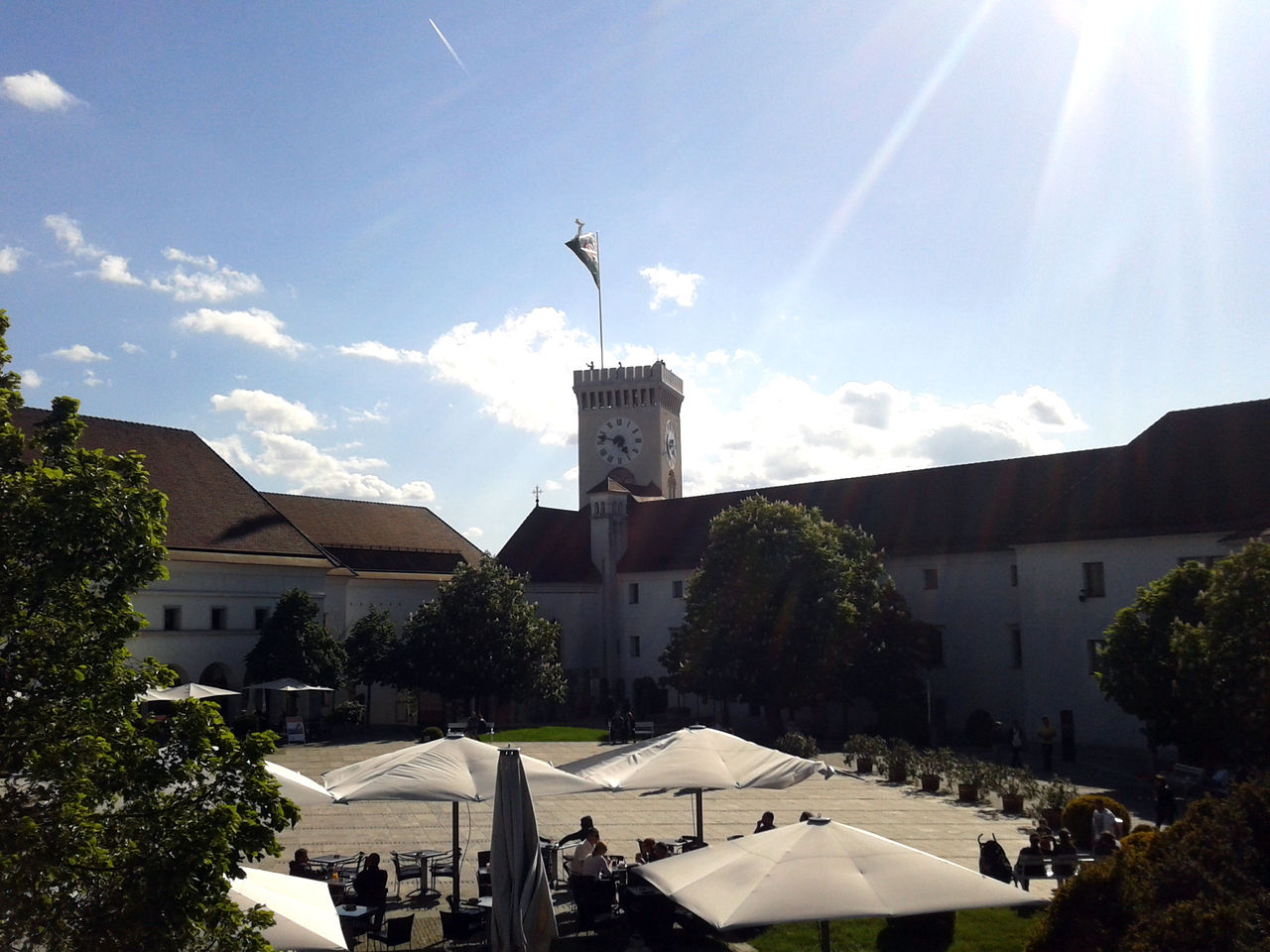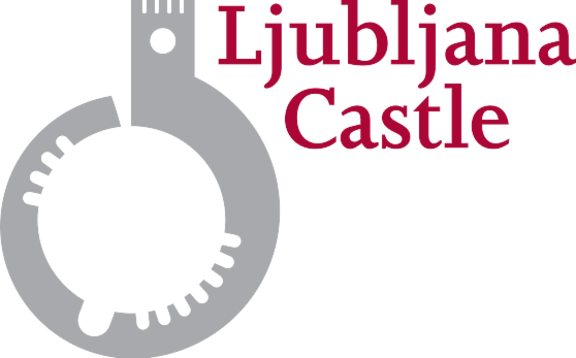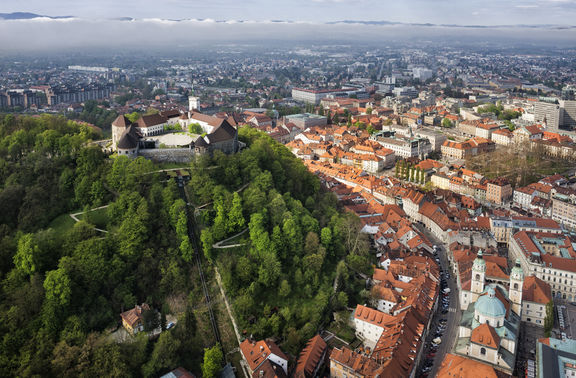Difference between revisions of "Ljubljanski grad Public Institute"
Anže Zorman (talk | contribs) |
|||
| Line 60: | Line 60: | ||
The better part of the permanent exhibitions at the castle are dealing with the history of the castle and the city bellow. One of them is the ''Virtual castle'', a twelve-minute projection showing the history and architectural development of the castle up until the present day. It is a complementary project to the ''Virtual Museum – Ljubljana Squares through the Ages'', prepared by the [[City Museum of Ljubljana]], which is now available to watch on-line. A similar topic is dealt with in the multimedia exposition ''iLjubljana'' that deals with the urban development of Ljubljana. | The better part of the permanent exhibitions at the castle are dealing with the history of the castle and the city bellow. One of them is the ''Virtual castle'', a twelve-minute projection showing the history and architectural development of the castle up until the present day. It is a complementary project to the ''Virtual Museum – Ljubljana Squares through the Ages'', prepared by the [[City Museum of Ljubljana]], which is now available to watch on-line. A similar topic is dealt with in the multimedia exposition ''iLjubljana'' that deals with the urban development of Ljubljana. | ||
| − | An important exhibition is the ''Slovenian History'', which uses original items, replicas, interactive content and multimedia presentations to outline the political, social, cultural and economic history of the Slovenian territories from prehistory onwards. Another elaborate but a bit more specific display is called ''The Penitentiary''. It deals with the techniques and artefacts of confinement and | + | An important exhibition is the ''Slovenian History'', which uses original items, replicas, interactive content and multimedia presentations to outline the political, social, cultural and economic history of the Slovenian territories from prehistory onwards. Another elaborate but a bit more specific display is called ''The Penitentiary''. It deals with the techniques, concepts and artefacts of confinement and punishment, a topic which was expanded with an additional exhibition about torture in 2015. |
| − | Finally, there is the [[Museum of Puppetry]], an ambitious project | + | Finally, there is the [[Museum of Puppetry]], an ambitious joint project of the [[Ljubljana Puppet Theatre]] and the [[Ljubljanski grad Public Institute]], supported by the [[Municipality of Ljubljana]], which presents the history of puppetry in Slovenia since the early days of the 20th century and also sets up regular puppet shows. |
==Art exhibitions== | ==Art exhibitions== | ||
| Line 72: | Line 72: | ||
==Educational events== | ==Educational events== | ||
| − | Educational contents at the castle span from | + | Educational contents at the castle span from history lectures and different guided tours (some even featuring costumed re-enactments of events from certain historical periods) to workshops for children. The latter are done on topics like the cultural legacy of the castle, folk legends and tales and the medieval life at the castle. |
Alongside these, there are also serious lectures and discussions on history and culture, many of them produced together with the researchers and experts from the [[Faculty of Arts, University of Ljubljana]], the [[National Museum of Contemporary History]] or the [[Museum and Galleries of Ljubljana]]. | Alongside these, there are also serious lectures and discussions on history and culture, many of them produced together with the researchers and experts from the [[Faculty of Arts, University of Ljubljana]], the [[National Museum of Contemporary History]] or the [[Museum and Galleries of Ljubljana]]. | ||
| Line 78: | Line 78: | ||
==Music, cinema and performative arts== | ==Music, cinema and performative arts== | ||
| − | There are | + | There are quite a few music cycles at the castle, with some of them conceptualised as a series of concerts in which an invited musician curates his own four or five collaborations with other artists. Some of those who were given this mandate were [[Milko Lazar]], [[Matjaž Drevenšek]], [[Tajda Lekše]], [[Mia Žnidarič]], [[Janez Dovč]], [[Uroš Perič]], [[Jure Tori]] and [[Vasko Atanasovski|Vasko Atanasovski Trio]]. |
| − | + | Another set of cycles presents classical music pieces, which were in 2015 coupled with the works of poets like William Shakespeare, Paul Eluard and Antonio Machado. Some of the invited musicians were Theresa Plut, Nadežda Tokarova, Denys Masliuk and Gavriel Lipkind. Occasional other musical events also take place, from pop music gigs to the [[Academic Choir Tone Tomšič, University of Ljubljana|Academic Choir Tone Tomšič]] concerts | |
| − | During the summertime, the castle courtyard is occupied by | + | During the summertime, the castle courtyard is occupied by [[Kinodvor Cinema]]'s film screenings called Film under the Stars (co-produced by the institute as well) and a stand-up series titled Comedy under the Stars (done in tandem with [[Gustav Film]]). This genre is also represented by an international stand-up comedy festival called [[Panč Festival]]. |
==See also== | ==See also== | ||
Revision as of 17:11, 5 October 2015
Permanent exhibitions
The better part of the permanent exhibitions at the castle are dealing with the history of the castle and the city bellow. One of them is the Virtual castle, a twelve-minute projection showing the history and architectural development of the castle up until the present day. It is a complementary project to the Virtual Museum – Ljubljana Squares through the Ages, prepared by the City Museum of Ljubljana, which is now available to watch on-line. A similar topic is dealt with in the multimedia exposition iLjubljana that deals with the urban development of Ljubljana.
An important exhibition is the Slovenian History, which uses original items, replicas, interactive content and multimedia presentations to outline the political, social, cultural and economic history of the Slovenian territories from prehistory onwards. Another elaborate but a bit more specific display is called The Penitentiary. It deals with the techniques, concepts and artefacts of confinement and punishment, a topic which was expanded with an additional exhibition about torture in 2015.
Finally, there is the Museum of Puppetry, an ambitious joint project of the Ljubljana Puppet Theatre and the Ljubljanski grad Public Institute, supported by the Municipality of Ljubljana, which presents the history of puppetry in Slovenia since the early days of the 20th century and also sets up regular puppet shows.
Art exhibitions
Graphic arts form a very important part of the institutes programme, which has – to name but a few – featured photographies done by Steve McCurry as well as some other collaborations with the National Geographic photographers; a contemporary ceramics exhibition co-produced with the International Ceramics Triennial Unicum; interdisciplinary spatial installations done by Urša Vidic as a part of City of Women International Festival; a display of contemporary Hungarian graphic artists (a joint project with the Hungarian Academy of Arts); and a number of other exhibitions, from children's creations to urbanistic planning.
Of the recent international partners, one can also name the Academy of Arts, Architecture and Design in Prague and the Venice Academy Gallery of Fine Art.
Educational events
Educational contents at the castle span from history lectures and different guided tours (some even featuring costumed re-enactments of events from certain historical periods) to workshops for children. The latter are done on topics like the cultural legacy of the castle, folk legends and tales and the medieval life at the castle.
Alongside these, there are also serious lectures and discussions on history and culture, many of them produced together with the researchers and experts from the Faculty of Arts, University of Ljubljana, the National Museum of Contemporary History or the Museum and Galleries of Ljubljana.
Music, cinema and performative arts
There are quite a few music cycles at the castle, with some of them conceptualised as a series of concerts in which an invited musician curates his own four or five collaborations with other artists. Some of those who were given this mandate were Milko Lazar, Matjaž Drevenšek, Tajda Lekše, Mia Žnidarič, Janez Dovč, Uroš Perič, Jure Tori and Vasko Atanasovski Trio.
Another set of cycles presents classical music pieces, which were in 2015 coupled with the works of poets like William Shakespeare, Paul Eluard and Antonio Machado. Some of the invited musicians were Theresa Plut, Nadežda Tokarova, Denys Masliuk and Gavriel Lipkind. Occasional other musical events also take place, from pop music gigs to the Academic Choir Tone Tomšič concerts
During the summertime, the castle courtyard is occupied by Kinodvor Cinema's film screenings called Film under the Stars (co-produced by the institute as well) and a stand-up series titled Comedy under the Stars (done in tandem with Gustav Film). This genre is also represented by an international stand-up comedy festival called Panč Festival.






